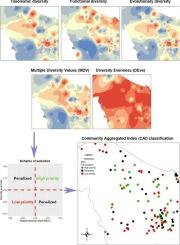CAI−Community Aggregated Index:结合多样性指数对物种组合进行排序和比较的工具
IF 2.5
3区 环境科学与生态学
Q2 BIODIVERSITY CONSERVATION
引用次数: 0
摘要
保护科学需要合适的方法来整合不同的生物多样性方面,从而为受威胁物种和群落提供具有成本效益的保护策略。近年来,利用物种丰富度、功能多样性、进化多样性和其他多种群落或多样性指标对物种组合(如群落)进行了空间比较。在这里,我建议使用二维社区指数(例如,社区汇总指数- CAI),能够执行多方面的站点级优先排序,作为保护规划的工具。CAI将第一个轴上分类、功能和进化多样性的标准化值(称为Multi diversity Value)的总和和第二个轴上三个标准化多样性值的均匀度(称为多样性均匀度)结合起来。在这两个轴的作用下,群落特征可以被划分为具有四个象限的二维空间。在本案例研究中,应用CAI识别了意大利中部三种不同栖息地的高优先级、惩罚级和低优先级鸟类群落。其他多样性指标可用于计算CAI,取代本研究中使用的指标。这种二维群落指数提供了一种多功能的工具,可以在群落之间进行比较,并有可能用于支持保护规划的决策过程。这些信息可用于确定区域的优先次序,并分配资源以保护社区/生态系统。本文章由计算机程序翻译,如有差异,请以英文原文为准。

CAI − Community Aggregated Index: a tool to rank and compare species assemblages combining diversity indices
Conservation science needs suitable methods for integrating different biodiversity facets to deliver cost-effective conservation strategies for threatened species and communities. In recent years, spatial comparisons based on species assemblages (e.g., communities) were performed using species richness, functional diversity, evolutionary diversity, and many other community or diversity metrics. Here, I propose using a bi-dimensional community index (e.g., Community Aggregated Index – CAI), capable of performing a multifaceted site-level prioritization, as a tool for conservation planning. CAI combines the overall sum of standardized values (named Multi Diverse Value) of taxonomic, functional, and evolutionary diversity in the first axis and the degree of uniformity (named Diversity Evenness) of the three standardized diversity values in the second axis. With these two axes, the communities characterized can be classified into a bi-dimensional space with four quadrants. In this case study, CAI was applied to identify the high-priority, penalized, and low-priority bird communities in three different habitats of Central Italy. Other diversity metrics can be used in the calculation of CAI, replacing the metrics used in this study. This bi-dimensional community index offers a versatile tool for creating comparisons among communities, with potential use to support the decision-making process in conservation planning. This information can be used to prioritize areas and allocate resources to the conservation of communities/ecosystems.
求助全文
通过发布文献求助,成功后即可免费获取论文全文。
去求助
来源期刊

Journal for Nature Conservation
环境科学-生态学
CiteScore
3.70
自引率
5.00%
发文量
151
审稿时长
7.9 weeks
期刊介绍:
The Journal for Nature Conservation addresses concepts, methods and techniques for nature conservation. This international and interdisciplinary journal encourages collaboration between scientists and practitioners, including the integration of biodiversity issues with social and economic concepts. Therefore, conceptual, technical and methodological papers, as well as reviews, research papers, and short communications are welcomed from a wide range of disciplines, including theoretical ecology, landscape ecology, restoration ecology, ecological modelling, and others, provided that there is a clear connection and immediate relevance to nature conservation.
Manuscripts without any immediate conservation context, such as inventories, distribution modelling, genetic studies, animal behaviour, plant physiology, will not be considered for this journal; though such data may be useful for conservationists and managers in the future, this is outside of the current scope of the journal.
 求助内容:
求助内容: 应助结果提醒方式:
应助结果提醒方式:


